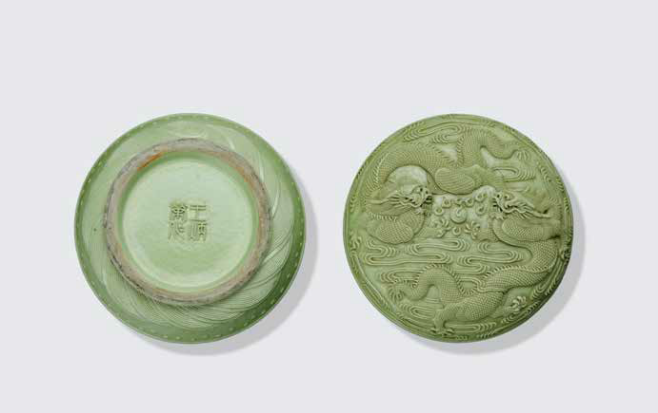Bonhams. FINE ASIAN WORKS OF ART, 18 Dec 2017, 11:00 PST -+ SAN FRANCISCO
20 décembre 2017
A carved lime green glazed porcelain seal paste box and cover, Wang Bingrong, 19th century
Lot 986. A carved lime green glazed porcelain seal paste box and cover, Wang Bingrong, 19th century; 3 1/4in (10.8cm) diameter; 1 1/2in (3.8cm) high. Estimate $4,000 - 6,000. Sold for US$ 8,750 (€7,387) inc. premium. © Bonhams 2001-2017
The circular box carved along the exterior side walls with a raised border of formalized waves below incised lines and raised dots indicating the splashes from the motion of crashing waves, the fitted cover crisply carved with two scaly five-clawed dragons, each with an open jaw and prominent fangs, the bulging eyes picked out in black, pursuing a flaming pearl amidst fluidly rendered wisps of cloud, the base finely carved in relief with a Wang Bingrong zuo mark, enclosed by a splayed circular foot ring, the exterior covered entirely in lime green glaze except the foot pad, the interior glazed in orange-red except the contact areas of the box and its cover.
Note: Traditionally, individual artists remained anonymous on artworks created in imperial China. With the exception of paintings and calligraphy, the names of the artists gave way to the imperial reign marks. But this custom began to change in the early nineteenth century. Although the imperial reign marks and important hall marks still represented unshakeable power and privilege, there was a growing impulse for artists and craftsmen to sign their wares if they became sufficiently well known among the patrons to warrant a personal identification.
Wang Bingrong, believed to have been active during the Tongzhi and Guangxu periods (1862-1908), was among the celebrated emerging artists who gained fame as a talented porcelain carver. According to Yinliuzhai Shuo Ci(Commentary on Porcelain from the Studio of Drinking Streams) composed by Xu Zhiheng during the Qing dynasty, Wang's best-known work was scholar's objects.
Dragons were among Wang's popular designs. It was characteristic that the eyes of the dragons in Wang's works were usually enameled in black. His dragons are executed in varying styles and positions, suggesting that the designs were more likely achieved by hand carving, not from mold.
When comparing the present example to a Wang Bingrong-inscribed porcelain snuff bottle from the Meriem Collection (refer to Christie's sale 1934, New York, 19 September 2007, lot 670), one can easily spot the similarities in the flow of the carving, the treatment of the carved dragon, and the use of the space on the object.
Publicité
Publicité
Commentaires

/https%3A%2F%2Fprofilepics.canalblog.com%2Fprofilepics%2F1%2F0%2F100183.jpg)
/https%3A%2F%2Fstorage.canalblog.com%2F03%2F02%2F119589%2F96711876_o.jpg)
/https%3A%2F%2Fstorage.canalblog.com%2F11%2F31%2F119589%2F94773502_o.jpg)
/https%3A%2F%2Fstorage.canalblog.com%2F20%2F83%2F119589%2F94772815_o.jpg)
/https%3A%2F%2Fstorage.canalblog.com%2F26%2F72%2F119589%2F75604929_o.jpg)
/https%3A%2F%2Fstorage.canalblog.com%2F59%2F60%2F119589%2F26458628_o.jpg)




/http%3A%2F%2Fstorage.canalblog.com%2F00%2F00%2F119589%2F129758935_o.jpg)
/http%3A%2F%2Fstorage.canalblog.com%2F29%2F28%2F119589%2F129637299_o.jpg)
/http%3A%2F%2Fstorage.canalblog.com%2F88%2F37%2F119589%2F129631480_o.jpg)
/http%3A%2F%2Fstorage.canalblog.com%2F77%2F79%2F119589%2F129631259_o.jpg)